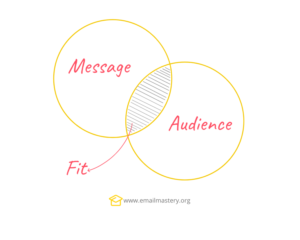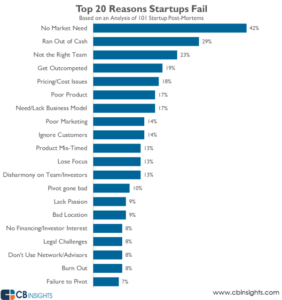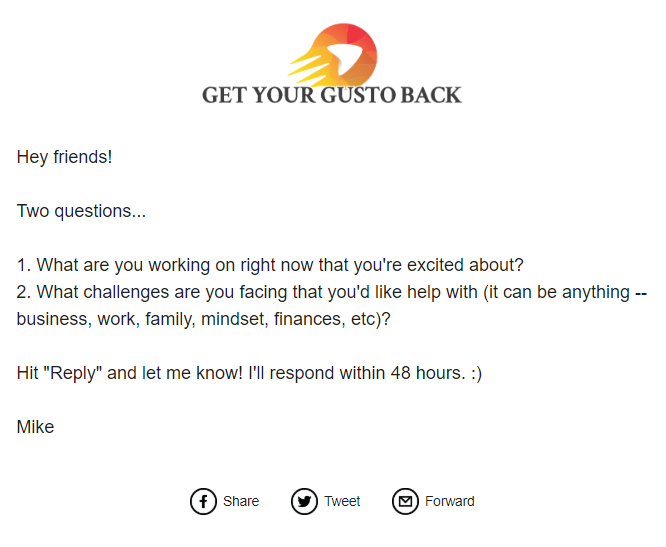Startup founders talk a lot about product-market fit.
Does the product fit the market? Is there a demand for the product? Which market, exactly, is interested in the product we’re creating?
But that concept isn’t only helpful for product development and general entrepreneurship, we can also apply that concept to email marketing.
Think about it.
The message you create needs to fit the audience you send that message to.
We call it a message-audience fit.
What Do We Mean by Message-Audience Fit?
Message-audience fit refers to meeting the needs of your audience via email.
This requires consistency between the email campaigns you send (the message) and the people you send those campaigns to (the audience).
Ultimately, it’s about meeting the audience’s expectations for what they want.
Message-audience fit includes the process of determining who your market is, who you want your market to be, and who the message you’ve crafted is intended for.
Achieving message-audience fit often requires segmenting your email list by interest, sending surveys to better understand your audience, and ensuring that the subscribers you attract are the subscribers you intend to attract.

Why is Message Audience Fit So Important?
To explain why message-audience fit is so important for any email marketing strategy, let’s discuss why product-market fit is important for a startup or business in general.
What happens if a product you’ve created doesn’t fit the market’s needs? What happens if the market you’re targeting doesn’t want what you’ve created?
Ultimately, sales suffer or your startup fails to grow.
And lest you think that’s an uncommon occurrence, consider that 42% of startups (the largest percentage by far) fail because there was no market need for their product.

In the end, there’s a big difference between creating a product and creating a product that people want.
Email marketing is no different — only, we’re not talking about a product, but messages, email campaigns, automations, and drip sequences.
If you don’t have product-market fit, nobody buys.
If you don’t have message-audience fit, few people open, fewer people click, and lots of people unsubscribe… because the message doesn’t fit what the audience wants.
In that case, there are only two options: change your message or change your audience.
How To Find Your Message-Audience Fit
You now understand what message-audience fit is and why it’s important.
But practically speaking, how do you achieve message-audience fit for your email marketing efforts?
How do you send the right message to the right people at the right time… and how do you do that over and over again?
Here are the steps:
Step #1: Determine Your Target Market’s Beliefs, Attitude, and Communication Style
Assuming that you already have an email list, there are three questions we need to answer.
First, who is your current audience?
Second, who do you want your audience to be? Or more pertinent, who do you need your audience to be in order to sell products and grow your business? Who is your target market?
And third, is your current audience your ideal audience?
Of course… that’s easy to ask and hard to answer.
How do you know if the audience you have is the audience you need? Also, how can you ensure that you build the right audience going forward?
Perhaps the easiest way to determine the beliefs, desires, and communication style of your existing audience is to send out a survey (you can use Typeform or Google Forms) and ask pertinent questions — things like…
- What are you hoping to get out of [BUSINESS NAME]?
- Why did you sign up for this email list?
- What is the most pressing issue in your life right now?
That will help you figure out if your subscribers are a good representation of your target market — do they want the things you’re selling?
You could also just send out an email with a few questions and ask for your audience to reply directly to the email.

However you do it, you must determine if the audience you have is the audience you need.
As for continuing to grow your email list with people from your target market, make sure that all of your advertising and marketing materials are preaching the same message and that that message is attractive to your ideal customers.
In particular, make sure that anything you offer in return for opting into your email list — ebooks, whitepapers, courses, giveaway items, etc — is going to attract the right people… your target market.
If, for example, you offer a chance to win a free iPad in return for people’s email addresses, there’s no guarantee that you’re collecting high-quality subscribers (who doesn’t want an iPad??).
But if you offer something that’s specifically attractive to your target market, you’ll capture not just any lead… the right leads.
Once you have a list full of people who you believe represent your target market, take every opportunity to learn more about who they are, what they want, and how they communicate.
Step #2: Find The Common Phrases Your Target Market Uses
If the message you send is going to match the audience you send it to, then you need to speak your target markets language.
You need to understand how they communicate and what phrases they use — are they casual, professional, fun-loving, laidback, or dead-serious?
Consider Huckberry as an example. Huckberry, an e-commerce company that generates about $4.4 million in revenue and 750,000 sales every single year.
And at least part of their success is due to the fact that they expertly speak the language of their customers — their copy, design, and tagline all are crafted to attract their target market.
Huckberry has a message-audience fit.
One example of this is the phrase they put at the end of every single email: “See you out there.”

Check Out Our Full Huckberry Email Marketing Teardown Over here!
Micah McKay, Director of Brand Management and Business Development at Huckberry, explains how they came up with that tagline…
“We try to speak in the language of our customers. ‘See you out there’, for example, is one of the taglines we always use in our emails because we hear customers saying that exact same thing to us.”
The more that you speak your target market’s language, the more that your target market will sign up for your email list in the first place and the longer they’ll stick around.
People naturally like messages that feel familiar and affirm what we already believe.
How can you speak your target market’s language?
And we’re not just talking about using certain phrases — how can you craft an entire brand that appeals to your target market? The font you use, the images and graphics, the colors, and the wording… everything.
Of course, you can’t know how to communicate with your target market unless you first know how your target market communicates.
Talk with your target market, get to know them, notice how they talk, try to identify their values, ask about their fundamental beliefs, and learn everything you can. The better you understand them, the more you can create a brand that attracts them.
Step #3: Match Your Messaging To The Audience You Want To Attract
Once you’ve determined how your target market communicates, what they believe, how they interact, and specific phrases that they use, you can consistently craft messages that resonate with them.
These are the elements of every email campaign that you should optimize to connect with your target market…
- Design — What type of design elements will your target market expect from a brand that gets them? Should you have a lot of colorful designs, just a few professional elements, or no design at all? Also, remember that every font subtly communicates something different. Should your font be professional, casual, silly, or fun-loving?
- Images — What images will resonate with your target market? Should you use images of what they desire or images of the struggle that they’re experiencing? Should you use images at all? What do they expect and how can you fulfill that expectation?
- Tone — What tone of voice best fits your target market? How do they talk and how can you talk like them? Are they casual or professional? Do they cuss? Are they straight-laced?
- Authority — How can you build trust and authority with each email? Some businesses include a testimonial in every email they send and some consistently emphasize their vision. Find a way that works for you and try to build a little extra trust with each email campaign.
- Value-Driven — The companies that do the worst at email marketing are the ones that try to sell, sell, sell. Every email tries to get the subscriber to purchase something. And while selling is important, it’s also important to provide your audience with free value in order to build a long-term relationship. Remember, you want them to look forward to your emails, not to be annoyed by your emails.
Additionally, you should segment your email list as needed.
Most businesses will have various target markets — or at least, different interests within a single target market.
And segmentation allows you to send the right message to the right person at the right time.
You can segment your email list based on where they came from in the first place (which might be an indication of interests or desires), demographics, location, behavior, timezone, or whatever other factors will help you achieve market-audience fit.
Conclusion
In the same way that product-market fit helps entrepreneurs to create and sell products that resonate with a specific group of people, message-audience fit can help email marketers craft messages that fit their audience.
Ultimately, every email campaign is only effective if it’s attractive to the audience who received that campaign.
And the message is only attractive if the message matches the audience… and the audience matches the message.
So… do you have a message-audience fit? If you have any questions, let us know on Twitter.
